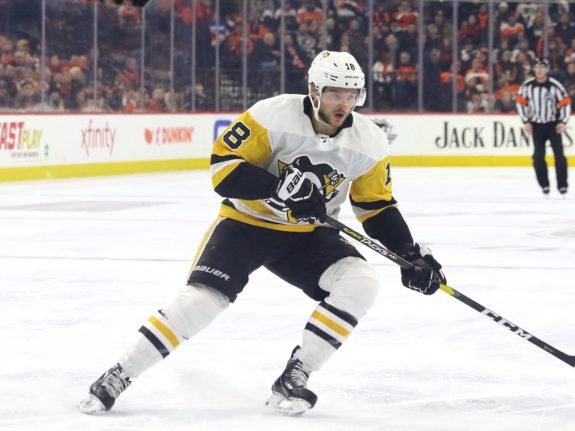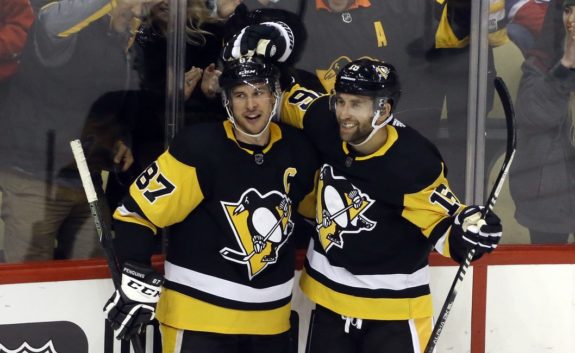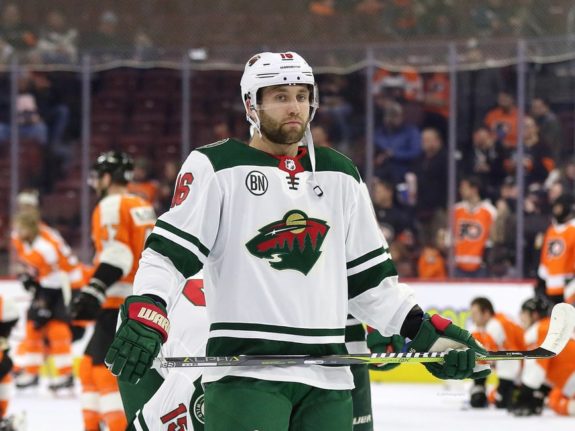When Pittsburgh Penguins general manager Jim Rutherford made yet another splash before this season’s trade deadline, sending the team’s 2020 first round pick, forward Alex Galchenyuk and top prospect Calen Addison to the Minnesota Wild for winger Jason Zucker, the buzz in local media circles and among Penguins fans was nearly unanimously positive. Yes, losing Addison hurts the club, but a late first-rounder is hardly a Mercedes.
Related: 20 Biggest NHL Trades in the Past Year
Meanwhile, the Galchenyuk experiment, a trial run that began following a one-for-one swap with the Arizona Coyotes, sending fan-favorite Phil Kessel to the desert, had turned into such a nightmare that Galchenyuk was approaching healthy scratch territory. Despite playing on one of the league’s hottest teams, he sported a 46.28 Corsi for percentage (CF%), well below league average, a score which found him in the company of players from the league’s worst teams (Ottawa Senators, San Jose Sharks, and Detroit Red Wings, to name a few).

Zucker, meanwhile, had been the organization’s dream add for years and was nearly a Penguin last spring before the trade was nixed by Kessel’s no-trade clause. His speed, which has become a calling card for Pittsburgh’s system, seemed a perfect match for the black and gold.
Related: Pennsylvania Hockey – A Long, Proud History
However, Rutherford’s deal for center Derick Brassard came with similar applause, but had thoroughly disappointing results. While playing on the wing of one of the best players in hockey history in Sidney Crosby should be a net positive regardless of the player, fans have also seen a substantial list of names fail to mesh with the future Hall-of-Famer (Kessel, James Neal, David Perron, to name a few). Would Zucker have similar growing pains?
Zucker-Crosby Duo Clicks Early
As of now, the answer seems to be ‘no.’ Goals are what is expected when you’re playing alongside Sid the Kid, and Zucker has delivered in that regard through five games, potting three pucks and adding an apple. While his early advanced statistics aren’t hot (a long-term CF% of 46 is not going to cut it), the production via the eye test is encouraging, to say the least. He also has a reputation as a two-way player, a pedigree demonstrated by his high-danger goals for percentage (HDGF%), a metric which measures goals for and against from high-percentage areas while you’re on the ice. In his last three full seasons with Minnesota in which he played 79, 82 and 81 games, Zucker recorded HDGF% of 75.93, 67.86 and 53.85.

The former two are especially eye-raising. The quandary of HDGF% is the number is often influenced by goaltending so it is at least possible that good or mediocre net protection can influence the number but not to the degree of a 75.93 or 67.86, well above the expected 50/50 threshold. In comparison, the only players in that ballpark this season play for powerhouse clubs (Boston Bruins and Tampa Bay Lightning) or play defense (players such as Nashville Predators stars Roman Josi and Ryan Ellis). Zucker, meanwhile, recorded a 75.93 and 67.86 while playing for the Wild. That’s simply mind-blowing and the sample size is too large to be a coincidence nor convenience. Zucker has that high a ceiling.
Looking Ahead
Given Zucker’s defensive accountability, expect whatever line he’s on to hold its own on a regular basis. Coach Mike Sullivan has already said he plans to move him around after starting him on Crosby’s line. While Zucker’s best fit on the team now is likely as Sid’s wingman, come next season Zucker may find himself paired with Evgeni Malkin as Jake Guentzel returns to his rightful spot alongside Crosby. Winger Dominik Simon, despite his lack of scoring, is a blessing in the top-six and it seems the Penguins know it.

Regardless of the course that occurs, Zucker provides the Penguins with a long-term piece and another strong top-six forward. It is indeed time for another playoff run and if the early results are any indication, Zucker is no Brassard. He’s something much more volatile than that.